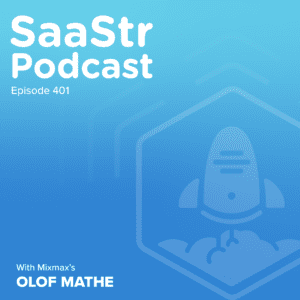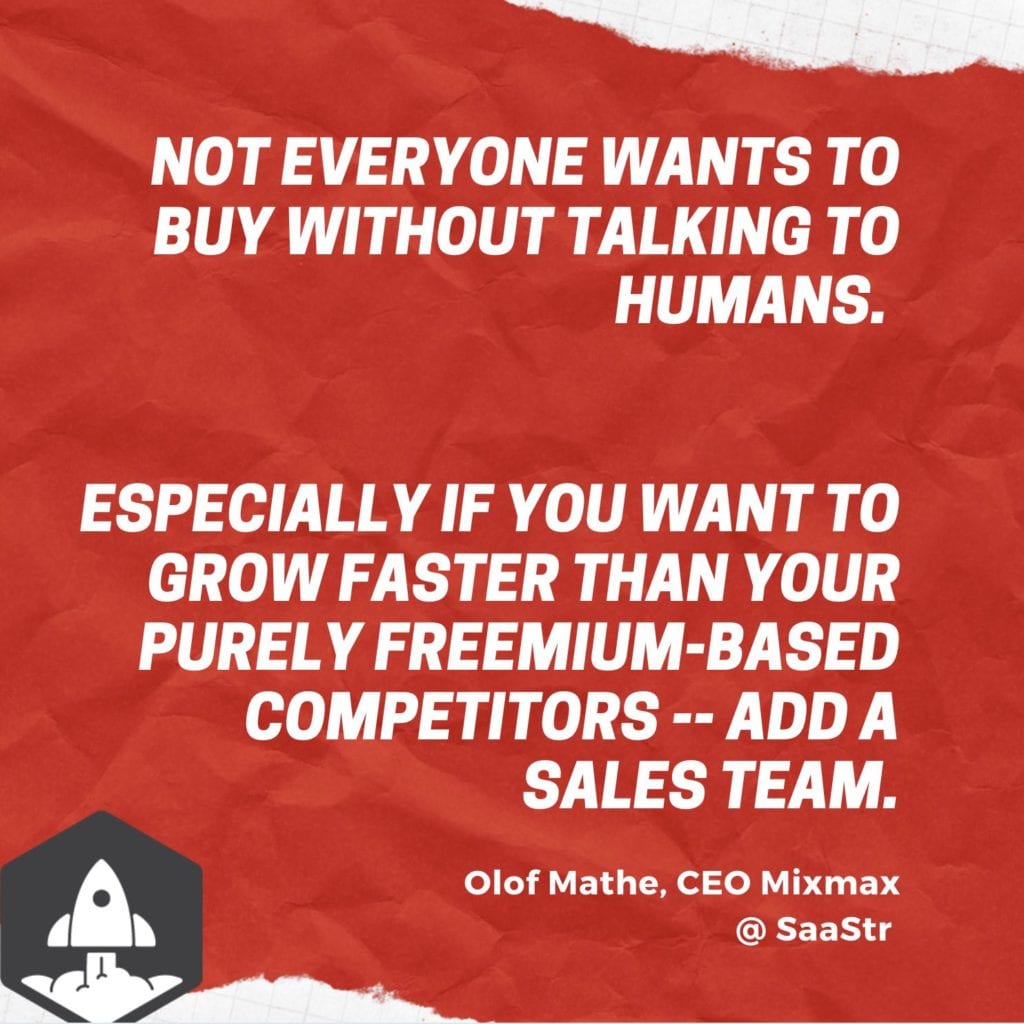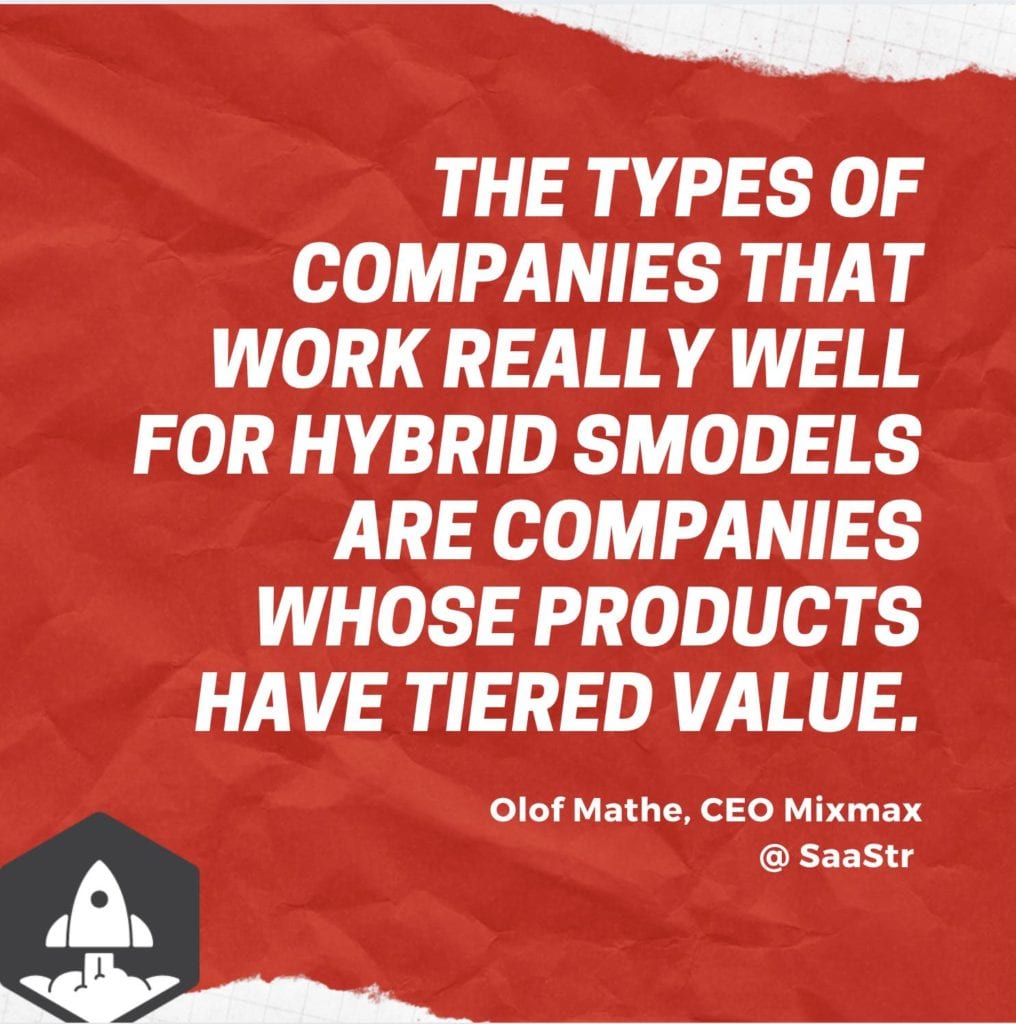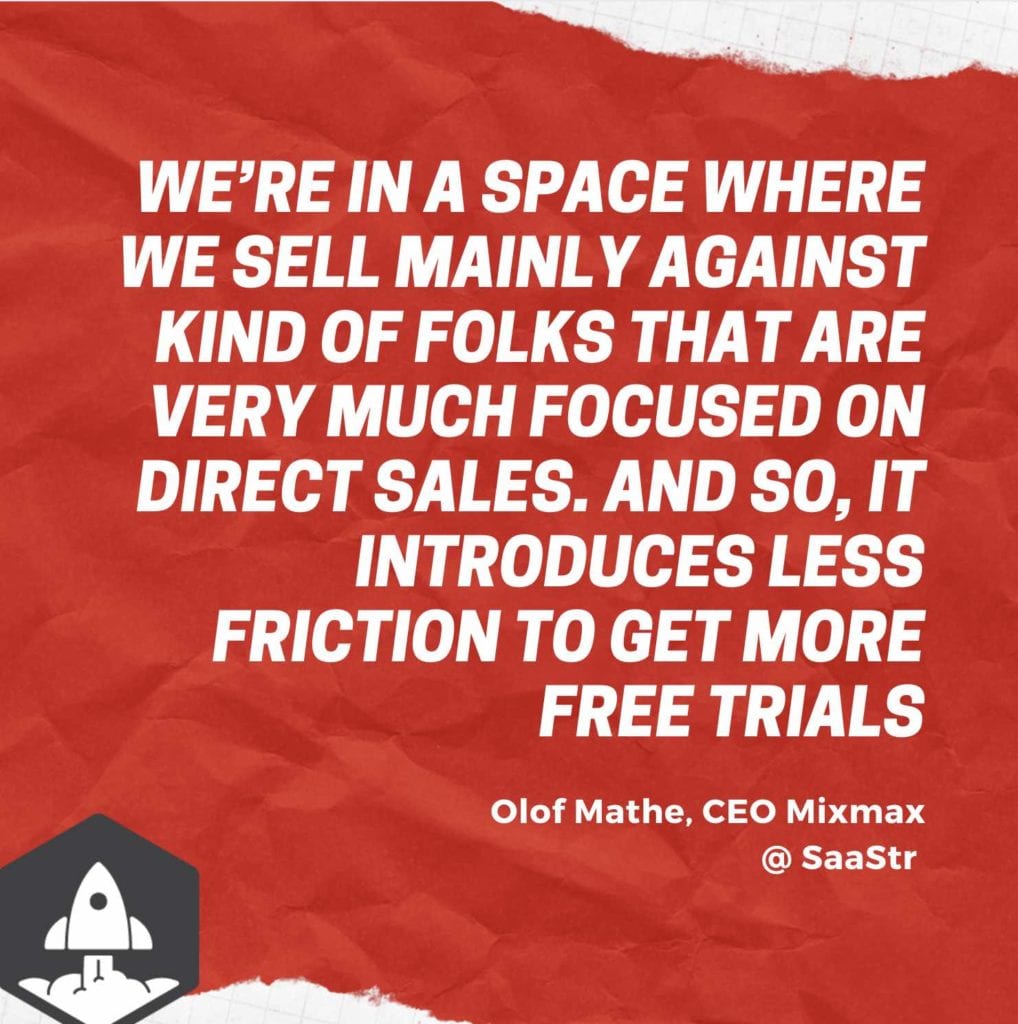
Ep #401: In this session, you will learn how to make the Freemium model work while also incorporating the traditional sales-driven strategy. Olof Mathe will share how the two strategies can blend together and specific lessons he has learned from his experience.
This episode is an excerpt of Olof’s session at SaaStr @ Home 2020. You can view the full video here.
If you would like to find out more about the show and the guests presented, you can follow us on Twitter here:
Jason Lemkin
SaaStr
Olof Mathé
Transcript:
Announcer:
This is SaaStr’s Founder’s Favorite Series, where you can hear some of the best of the best from SaaStr speakers. This is where the cloud meets.
Announcer:
Up today, the secrets to doing freemium and sales-driven sales at the same time with Mixmax CEO, Olof Mathé.
Olof Mathé:
Hi, everyone. I’m Olof Mathé. I’m the CEO and co-founder of Mixmax. We’re a sales automation platform, and I’m so excited to share the secrets of doing both freemium and a sales-driven model at the same time. And so y’all SaaS aficionados are probably thinking we’re completely crazy to mix both freemium and sales. And I’m here to tell you, in part, why you’re right.
Olof Mathé:
And so here are a couple of the things that we’re going to cover today. We’re going to talk about why having a hybrid model between freemium and sales is crazy and why you should be doing it anyway. I’ll share the three key questions to answer when you’re going hybrid, so you get your hybrid model exactly right. And then, I’ll share just a personal experience of going hybrid, all the challenges we faced, how we overcame them, some of the challenges we’re still working on, and then the opportunities we found in going hybrid.
Olof Mathé:
So first of all, what are the two models? What do we mean when we talk about freemium and direct sales? Well, this is kind of the traditional way we think about sales in SaaS. It’s the dichotomy between freemium and direct or enterprise sales. Enterprise sales is probably where SaaS started out. It’s the CEO, co-founder jumping on a plane to close a deal. It’s the wine and dine. It’s the opaque pricing, but hopefully the customer gets exactly what they need at the end.
Olof Mathé:
Freemium, on the other hand, I think is being really popularized by a SaaS product like Dropbox, where it was about having a really low friction product with massive reach. And then some subset of those people would upgrade. Of course, they never talked to a human. They had to figure everything out on their own. They never got any attention, really. And if there was support, it wasn’t bespoke at all.
Olof Mathé:
And so what’s cool today is that we’re seeing increasingly best in breed SaaS companies that are doing a hybrid between these two models. And why do they do that? Well, hybrid matters because SaaS today, is so mature. And you’re always up against an incumbent or competitor that has more market share. And so, it’s just a great way to differentiate. I’m sure some of you are familiar with this picture of the MarTech 5,000, just to show. And I can’t make out a single logo, which of course is purposeful, just to show how crowded marketing tech is. It’s the same in sales tech, the space we’re in, in finance tech, in develop deployment tech. Whatever part of SAS you’re in, it’s crowded, and there’s an incumbent you’re up against.
Olof Mathé:
And so typically, you have kind of two ways to differentiate yourself. Either you can focus on a better product experience or a better buying experience. And so, if you’re up against an incumbent that tends to lean more on direct sales and have the more direct sales heavy approach, you can differentiate yourself by having free or freemium as part of your mix. And again, the reason you do that is not to get crazy reach. It’s mainly to reduce friction so much that you can get a trial. Because the buyer is always going to be incented to go with the incumbent or the competitor that has more market share than you for the time being.

Olof Mathé:
Now on the other side, if you’re in a category where freemium is more prevalent with kind of a broader use cases, you can differentiate by having a way better buying experience. And what that typically means is layering on some kind of sales experience or human attention on the buying experience. Because hey, not everyone wants to buy without talking to humans. And especially if you want to grow faster than your purely freemium-based competitors, that can be a great, great strategy. So going hybrid is a great way to differentiate yourself in SaaS since it’s so mature today.
Olof Mathé:
So, how do you pick a hybrid SaaS model that really works? And how do you find the right fit that works just for you? Here’s what we’ll go through, the three key questions to ask yourself when going hybrid and figuring out your sales model. So you’ll notice, by the way, that these are kind of like a sales funnel. And that’s exactly how I would think about them. First of all, you need to ask yourself, how do you qualify your leads? What information are you asking from people that sign up for demos or sign up for your product? Then, how do you show value? Is this entirely self-directed, the lead is on their own? Or are you giving them some kind of bespoke concierge experience? And lastly, how do you sell? Is pricing on the website? Is it a PayK? Does the lead have to pick up the phone to call your sales team? Or can they just put down their credit card?
Olof Mathé:
And so, as you think about these dimensions, and you’ll notice that typically, in the old world, freemium was just like very permissive. And in the old world, direct sales was pretty restrictive. And now we’re starting to see interesting hybrid. So I’ll go through kind of the dimensions for each of these.
Olof Mathé:
So firstly, how do you qualify? And what’s the full plethora of options you have available to yourself? Well, for qualification, there’s actually a lot, from asking your leads for absolutely nothing. They can try out the product without even giving you their email address. This, I feel is one of the most underutilized ways in SaaS. It isn’t that prevalent. I think, Boomerang, the Chrome extension had this on one of their products. Sites like Alexa kind of have this. You can do things like asking for an email address or OAuth, which is pretty slick.
Olof Mathé:
Of course, we have the forms and surveys, some of which are very lengthy. And of course, none of us enjoy saying, you know what I’m primarily interested in. Here’s my role. And no one ever enjoy chatting to a chat bot. And then of course, you have the full actually having to talk to human before even potentially getting access to the product. Now what’s interesting here is, today we even see some freemium products that are adopting either very lengthy forms or surveys, even live calls, before you get in. And then some companies that rely more on sales that try to open up the top of the funnels so much, that they have very, very light call or just invest heavily in automated sourcing to reduce friction for the user.
Olof Mathé:
Now, of course, qualification isn’t fun and the best types of qualifications are probably the ones that actually show us value. And that goes to the other dimension. How do you show value to people that, your leads, that have signed up and are on board? Well, here again, you have kind of a full set of options from completely self-served, self-directed, figure it out on your own, to sales or success, doing some kind of intro meeting with you to show the value of the product. But typically, it’s one-off when you’re on your own, to something that’s much more concierge-ish, bespoke, you’re mapping sales force fields together, and they’re really, really out to solve your problem.
Olof Mathé:
And again, here, in the old world, freemium was almost always just self-directed. Direct sales was much more on the concierge side. Now we have some freemium products that rely heavily on pretty deep onboarding. And some sales products, well, sales comes in very late. And a lot of the initial discovery is actually self-directed, in part, because perhaps the target audience doesn’t actually want to be sold to. So a lot of options here for you to think through as you choose your hybrid model.
Olof Mathé:
And then of course, when it comes to the sell, how are you going to do that? Well, here again, a lot of options from open, what I call more, an open model to a more closed one. Open, being there’s a free version of the product, or perhaps the product’s free. It’s typically self-served, through to pricing’s opaque, you have to pay for the product. You have to talk to the sales team, and with everything in between from putting in your credit card to get a trial, having a free trial being bounced back to free, or perhaps even getting shut off once your trial is over. So a lot of different options for you to think through here.
Olof Mathé:
So those are the three questions to think through, what type of model do you want your various stakeholders going through at every point in the journey? And so here, I’d like to share what the hard lessons are from the choices we made in choosing a hybrid model. Because we went pretty much across all of these dimensions rather than choosing just the standard freemium or the standard sales model. And in a way you can say, we actually have a mix of both.

Olof Mathé:
The first thing I’d like to clarify is certain types of companies are more better suited to hybrid models. And I would say the types of companies that work really well for hybrid models are companies whose products have tiered value. And so what do I mean by that? Well, I think a company like Figma is a really good example of this. Figma is built for design, but not just designers. So Figma, as you know, is a design platform. Designers make mocks and interactive prototypes in Figma, but there a whole set of other stakeholders that use and interact and get value from Figma, engineers, product people, even some folks on the go-to-market team.
Olof Mathé:
Now, of course, designers are the ones that get most value. And all these roles are kind of ancillary, but they’re still getting value. And the cool thing about this is since they have many different types of stakeholders, that opens up for really interesting expansion opportunities and growth opportunities within accounts, especially larger accounts. Looker is kind of similar. It’s built for data science, but not just data scientists. A whole variety of different stakeholders rely on Looker charts and modify them and look at them, and are getting value. And so what this means for companies that have different types of stakeholders, hybrid models are really useful, because at different times in the life cycle, you want to engage with your leads differently. And so this is where it comes to us, and I’m just sharing to get a sense for the hybrid model we chose. We’re a sales automation platform. We’re built for sales, but not just salespeople.
Olof Mathé:
In fact, some of the core use cases salespeople have around scheduling and email tracking, almost everyone on a revenue team or anyone who talks outside of the company needs. And so our hybrid model, which we chose, and I’ll go into some of the challenges of this, was having a free plan to get massive virality and reach, and then giving users the option to choose a free trial of our paid plan, where if you don’t want to pay, you bounce back on free.
Olof Mathé:
And so for qual and showing value and selling, we’re actually across all of these dimensions. We try to reduce a lot of friction upfront by just having OAuth and automated scoring. Yet, if you’re a really good lead, we’ll actually try to call you so our sales team engages with you. In terms of showing value, we’re mainly self-directed. But if you’re a great lead, we’ll really try to concierge it with you and map out sales force fields and create amazing automations with you.
Olof Mathé:
And then on the sales side, while we rely really on direct sales to sell big contracts, we love when you just pay out of pocket as well. So you can imagine that this creates some conflict internally, and there are challenges with it. And that’s the meat of this. So let’s talk about qualification.
Olof Mathé:
So, challenges for us have been the SDR role gets pretty rich and actually kind of complicated. You just can’t have a canned discovery process. Because people have signed up to use the product. They didn’t sign up to get qualified. And so your SDRs need to show a ton of product value and be your leads’ best friends in helping them achieve what they want to achieve. And that means that you need a very special breed of sales leadership and a very special breed of SDR, which isn’t given.

Olof Mathé:
Secondly, another challenge of course, is just on the product side. Why top the funnel? We get high-ACV customers, low-ACV customers, users, and then people actually sign the checks, which are buyers. So who do you optimize for? That can create a lot of internal conflict and confusion. And so what helped us there, was making a very explicit exec decision on our focus, where we said 20, 25% of product and engineering team attention is going to acquisition and top of funnel, and the rest on the core features and value add that we saw in direct sales. And of course with this, there’s a lot of opportunity. Because we’re in a space where we sell mainly against kind of folks that are very much focused on direct sales. And so, it introduces less friction to get more trials. And with this, with really smooth quality, you’ll get lots of leads and lots of users for experimentation. So a lot of expansion opportunity there as well.
Olof Mathé:
Okay, what about showing value? Because we’re mainly self-directed, but then we have this concierge approach as well. What are some of the challenges with that? Well, here, I’d say the biggest challenge and one we’re still working through is, how do you make sure your highest valued leads and accounts are getting the right experience? How do you even get in touch with them? And then, even if you’re able to set up a structured trial, almost everyone who’s doing that trial will have their own experience instead of preconceived notions about the product, because it was self-directed. And that is definitely a double double-edged sword. So something to keep in mind when you choose the hybrid model.
Olof Mathé:
Now there are a lot of opportunities in having a product that can support self-directed. And that is really quick time to value, fast deal cycles, implementations, high win rates. Your CS and support teams, they’ll start to be the much more revenue generators versus cost centers. And even if you’re lucky… well, if you’re not lucky and an account churns, folks will come back because they can use it on their own. When you have both money coming in from self-serve and direct sales, that just, you can almost hear the conflict straightaway internally, right?
Olof Mathé:
So first of all, reps are going to get distracted by lower value activities. It’s really easy for them to claim self-serve leads as their own. They might engage with the lead that ultimately buy self-serve, they might try to convert monthly deals to annuals. Really, really tricky. And so here, what helped with for us was being very strict on a minimum deal size for direct sales. And then of course, you have the question of, hey, which revenue channel are you going to optimize, especially if they’re roughly the same size and growing at the same rate? And here, what helped us a lot was making an executive decision to say that free and self-serve, are just for reducing friction top of funnel to get more leads. And what we really optimize for is direct sales. So that helped us.
Olof Mathé:
And of course the beauty of this, and I’d say the main opportunity is, suddenly your sales motion is not just an inbound or outbound one, but it’s kind of a hybrid inbound-outbound model. You get folks who come inbound, and then you can start to outbound decision makers at the account. So outbound is never truly cold outbound, which creates a lot of nice opportunity for your sales team.
Olof Mathé:
Secondly, when self service mainly to create leads, you start to view that money almost as free cash flow and negative CAC leads, which is kind of nice. And of course, if in the sales process, you end up not winning a deal, you’re still going to keep the super fans that paid out of pocket. So it’s a future upsell opportunity. So with a lot of challenges that require a lot of exec decisions, but also create opportunities.
Olof Mathé:
Hybrid models, why are they awesome? Well, they can really help differentiate when you’re up on folks who rely more heavily on freemium and more heavily on sales. You’re going to need to figure out how to qualify, show value, and sell, and make the interface between those really smooth. And to really make this work, you’re going to need a separate breed of rep that is somewhat different. You going to need to think about free and self-serve, not so much as a separate revenue channel, but really about being a friction reducer to get more trials. And then you have to be ready to make a lot of exec decisions on where to focus and what degree of resource allocation you should have on different areas. So hopefully that can help inspire you in terms of figuring out your own hybrid model and why it’s important.
Announcer:
Bandwidth makes it easy to add enterprise-grade voice calling, text messaging, and emergency calling to your platform, all backed by the power of a fully owned and operated tier one carrier network, that gives you direct-to-carrier pricing with better quality, control, and insights that other API providers can’t. See why the biggest brands in the world rely on bandwidth and sign up for a free trial at bandwidth.com/SaaStr.
Announcer:
Visit dell.com/SaaStr for exclusive savings on Dell products and more information about the Dell for Entrepreneurs program. Everything from Dell financial services to Dell rewards, Dell for Entrepreneurs wants to help your business run smarter through technology.

